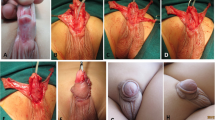Abstract
Objectives
Topical steroids have been advocated as an effective alternative treatment to circumcision in boys with phimosis. We evaluated the effectiveness of topical steroid therapy compared to a placebo neutral cream in 240 patients with phimosis.
Methods
A prospective study was carried out over a 24-months period, on an out-patient basis on two groups of patients with phimosis. One-hundred twenty patients applied a steroid cream twice a day for 4 weeks, and another group of 120 pts used a placebo cream twice a day for 4 weeks. Patients were assigned to either group by a computer-generated random choice.
Results
All patients in our series completed the two treatment periods without interruption. At a median follow-up of 20 months (6–30 months) therapeutic success was obtained in 43.75% (99/240) of cases, independently of the protocol. In particular, therapeutic success was obtained in 65.8% (79/120) of cases in the steroids group and in 16.6% (20/120) of cases in the placebo group, the difference being statistically significant (P < 0.0001, Mann–Withney test).
Conclusion
Our study shows that topical steroids represent a good alternative to surgery in case of phimosis. Steroid therapy using monometasone furoate 0.1% in our series gave better results that placebo with an overall efficacy of 65.8%. In patients where a phimotic ring persist after steroid therapy, circumcision is mandatory.
Similar content being viewed by others
References
Ashfield JE, Nickel KR, Siemens DR, MacNeily AE, Nickel JC (2003) Treatment of phimosis with topical steroids in 194 children. J Urol 169:1106–1110
Elmore JM, Baker LA, Snodgrass WT (2002) Topical steroid therapy as an alternative to circumcision for phimosis younger than 3 years. J Urol 168:1746–1750
Kayaba H, Tamura H, Kitajima S, Fujiwara Y, Kato T, Kato T (1996) Analysis of shape and retractability of the prepuce in 603 Japanese boys. J Urol 156:1813–1815
Atilla MK, Dundaro R, Odabas O, Ozturk H, Akin R, Gokcay E (1997) A nonsurgical approach to the treatment of phimosis: local nonsteroidal anti-inflammatory ointment application. J Urol 158:196–201
Golubovic Z, Milanovic D, Vukadinovic V, Rakic I, Perovic S (1996) The conservative treatment of phimosis in boys. Br J Urol 78:786–790
Kikiros CS, Beasley SW, Woodward AA (1993) The response of phimosis to local steroid application. Pediatr Surg Int 8:329–332
Chu CC, Chen KC, Diau GY (1999) Topical steroid treatment of phimosis in boys. J Urol 162:861–864
Monsour MA, Rabinovitch HH, Dean GE (1999) Medical management of phimosis in children: our experience with topical steroids. J Urol 162:1162–1167
Orsola A, Caffaratti J, Garat JM (2000) Conservative treatment of phimosis in children using a topical steroid. Urology 56:307–310
Kragballe K (1989) Topical corticosteroids: mechanisms of action. Acta Derm Venereol 151:7–10
Ng WT, Fan N, Wong CK, Leung SL, Yuen KS, Sze YS (2001) Treatment of childhood phimosis with a moderately potent topical steroid. ANZ J Surg 71:541–543
Wright JE (1994) The treatment of childhood phimosis with topical steroid. Aust N Z J Surg 64:327–330
To T, Agha M, Dick PT, Feldman W (1998) Cohort study on circumcision of newborn boys and subsequent risk of urinarytract infection. Lancet 352:1813–1817
Cuckow PM (1998) Circumcision. In: Stringer MD, Oldham KT, Mouriquand P, Howard ER (eds) Pediatric surgery and urology: long term outcomes. W. B. Saunders Co Ltd, London, pp 616–620
Krafchik BR (1995) The use of topical steroids in children. Semin Dermatol 14:70–74
MacKie RM (2004) Drug eruptions. In: Lay G, Ragon FG (eds) Clinical dermatology, Oxford University Press, New York, pp 300–310
Perry RJ, Findlay CA, Donaldson MD (2002) Cushing’s syndrome, growth impairment, and occult adrenal suppression associated with intranasal steroids. Arch Dis Child 87:45–49
Zheng PS, Lavker RM, Lehmann P, Kligman AM (1984) Morphologic investigations on the rebound phenomenon after corticosteroid-induced atrophy in human skin. J Invest Dermatol 82:345–347
Author information
Authors and Affiliations
Corresponding author
Rights and permissions
About this article
Cite this article
Esposito, C., Centonze, A., Alicchio, F. et al. Topical steroid application versus circumcision in pediatric patients with phimosis: a prospective randomized placebo controlled clinical trial. World J Urol 26, 187–190 (2008). https://doi.org/10.1007/s00345-007-0231-2
Received:
Accepted:
Published:
Issue Date:
DOI: https://doi.org/10.1007/s00345-007-0231-2




